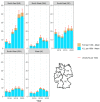Germany's Burden of Disease of Bloodstream Infections Due to Vancomycin-Resistant Enterococcus faecium between 2015-2020
- PMID: 36422343
- PMCID: PMC9717732
- DOI: 10.3390/microorganisms10112273
Germany's Burden of Disease of Bloodstream Infections Due to Vancomycin-Resistant Enterococcus faecium between 2015-2020
Abstract
In Germany, there is an increasing amount of vancomycin-resistant Enterococcus faecium (VREfm) isolates in bloodstream infections (BSIs); however, estimates on recent incidences and disease burden are missing. We aim to estimate the incidence and calculate the annual disease burden in disease-adjusted life years (DALYs) for BSIs due to VREfm in Germany between 2015 and 2020 to support informed decision-making in the field of antimicrobial resistance (AMR). We used the Antibiotic Resistance Surveillance (ARS) system data to obtain incidence estimates. The estimated incidences were used in the Burden of Communicable Disease in Europe (BCoDE) toolkit to calculate the attributable DALYs. A total of 3417 VREfm blood culture-positive isolates were observed within ARS. The estimated incidence of VREfm-BSIs per 100,000 inhabitants increased from 1.4 (95% Uncertainty Interval [UI]: 0.8−1.9) in 2015 to 2.9 (95% UI: 2.4−3.3) in 2020. The estimated burden, expressed in DALYs per 100,000 inhabitants, increased from 8.5 (95% UI: 7.3−9.7; YLD = 0.9, YLL = 7.6) in 2015 to 15.6 (95% UI: 14.6−16.6; YLD = 1.6, YLL = 14) in 2020. The most affected groups within the observed period are the 65−69-year-old males with 262.9 DALYs per 100,000 inhabitants, and in the younger age groups (<30 years), the under-one-year-old with 43.1 DALYs per 100,000 inhabitants and 34.5 DALYs for male and female, respectively. The increasing DALYs of BSIs due to VREfm require targeted prevention and control measures to address their unequal distribution across gender and age, especially for older hospitalized patients, neonates, and infants in Germany.
Keywords: DALYs; Enterococcus faecium; VRE; VREfm; antimicrobial resistance; bloodstream infection; burden of disease; vancomycin-resistance.
Conflict of interest statement
There is no potential conflict of interest by any authors.
Figures



References
-
- World Health Organization . Report of the 6th Meeting of the WHO Advisory Group on Integrated Surveillance of Antimicrobial Resistance with AGISAR 5-Year Strategic Framework to Support Implementation of the Global Action Plan on Antimicrobial Resistance (2015–2019), 10–12 June 2015, Seoul, Republic of Korea. World Health Organization; Geneva, Switzerland: 2015.
-
- Cassini A., Högberg L.D., Plachouras D., Quattrocchi A., Hoxha A., Simonsen G.S., Colomb-Cotinat M., Kretzschmar M.E., Devleesschauwer B., Cecchini M., et al. Attributable deaths and disability-adjusted life-years caused by infections with antibiotic-resistant bacteria in the EU and the European Economic Area in 2015: A population-level modelling analysis. Lancet Infect. Dis. 2019;19:56–66. doi: 10.1016/S1473-3099(18)30605-4. - DOI - PMC - PubMed
-
- Kassebaum N.J., Arora M., Barber R.M., Bhutta Z.A., Brown J., Carter A., Casey D.C., Charlson F.J., Coates M.M., Coggeshall M. Global, regional, and national disability-adjusted life-years (DALYs) for 315 diseases and injuries and healthy life expectancy (HALE), 1990–2015: A systematic analysis for the Global Burden of Disease Study 2015. Lancet. 2016;388:1603–1658. doi: 10.1016/S0140-6736(16)31460-X. - DOI - PMC - PubMed
LinkOut - more resources
Full Text Sources

